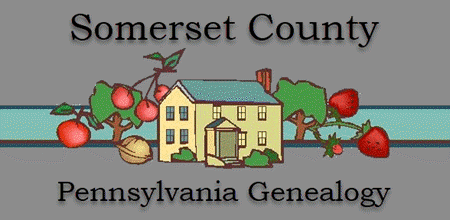History in the CountySomerset County history was recorded and published in several volumes back in the 1880's. Some of these books are out of print but many libraries, FHC's, and societies have copies in their reference sections.
Also see: Larry D. Smith hosts the Mother Bedford website... includes information regarding Old Bedford County, specifically with details on American Revolutionary life. See also, Mother Bedford and the American Revolution for information on ordering Larry's new book! History of The CountyThe following information was gleaned from a variety of sources.
The county of Somerset was created April 17, 1795 from the western part of Bedford County lying between the Allegheny Mountain range to the Laurel Hill range, and was named for Somersetshire, England. It is bounded on the south by the Mason Dixon line and on the north by Cambria County, which was part of Somerset County prior to its formation in 1804. The highest elevation found in Pennsylavania is located in Somerset County and high elevations are consistent throughout the county. The area was included in the Indian Purchase of 1768 and became part of Cumberland County until 1771 when Bedford County was formed. Somerset, the county seat, was laid out in 1795, incorporated as a borough on March 5, 1804 and was located on the turnpike road leading from Bedford to Pittsburgh, now known at Route 31. The waters of the county drain through the Conemaugh River to the Allegheny River, the Casselman River to the Youghiogheny River and through Wills Creek to the Potomac River at Cumberland, MD. Old Bedford County HistoryOld Bedford County was erected from Cumberland County in 1771 with Robert McCrea, William Miller, and Robert Moore as appointed commissioners. The area of this county was immense for it held within its limits twenty present counties or atleast parts of twenty counties. The town of Bedford dates back to at least 1751 when a man named Rea settled on the bank of the Juniata River. There was a fort or a defense of some kind in the locality before 1758 when Forbes came through engaged in cutting the military road through to Fort Pitt (Pittsburgh). The place was first call Raystown, but shortly after was called Fort Bedford or Bedford. A colorful description of this outpost can be found in Harvey Allen's Historical Novel, "Bedford Village". The turnpike from Philadelphia to Pittsburgh passed through the village. Washington's headquarters used during the Whiskey Rebellion (1794) is still standing on main street. Morrison's Cove is often mentioned as a landmark in early wills and records of importance. It is a fertile valley eight miles wide and 12 miles long, and extends into present Blair and Centre Counties. Wills Creek Valley and Friend's Cove are also in this section of the state and were well known to the early settlers.
Published Reference Books on Somerset CountyThe Historical and Genealogical Society of Somerset County should have copies of these publications as well as some of the LDS Family History Centers, nationwide, The Hoenstine Rental Library, and any major County and Public Libraries. Please ask your librarian or curator to help you find these valuable sources.
Published PeriodicalsThe Historical and Genealogical Society of Somerset County publishes a quarterly historical newsletter, The Laurel Messenger. This is a must for anyone researching their family history in Somerset County. Many FHC's subscribe to this quarterly publication -- ask your librarian. Please contact the society directly for information regarding fees for joining. You can write to them at the address below or call: (814) 445-6077. The Historical and Genealogical Society of Somerset County County Religious HistorySomerset County was home to many religious sects who journeyed from the Palatinate of Germany (France, Switzerland, and Bavaria) to find freedom from intolerable persecution. Among the religious strongholds of the late 1700's and 1800's were the Amish Mennonites who came from the Lancaster, Berks and Chester, PA areas in search of abundant land and close communal living; and the German Baptist Brethren or "Dunkers," of similar beliefs and background to the Amish who settled much of the southern portions of the county. |


![[PA] GenWeb](images/pamainlogo225_.jpg)